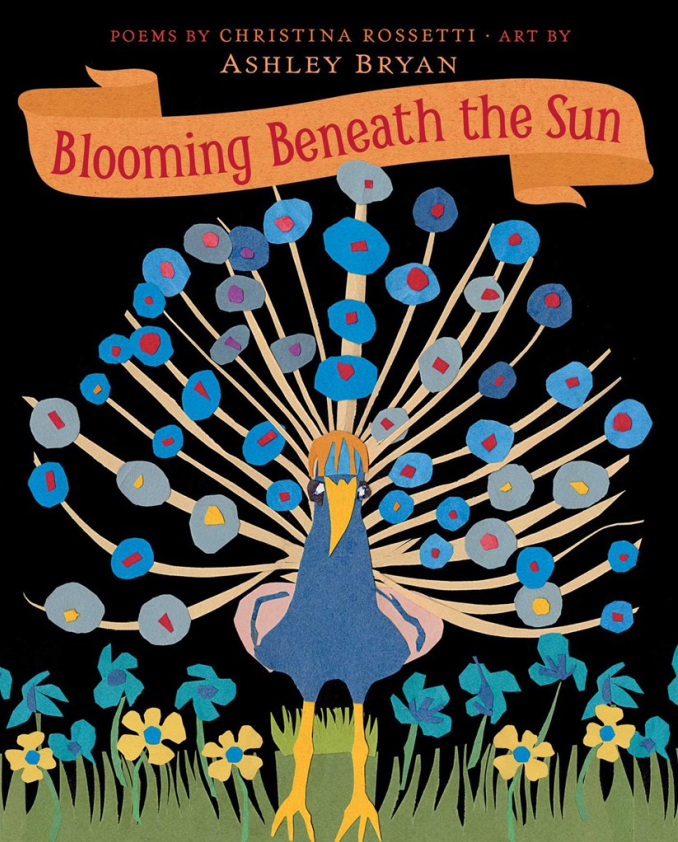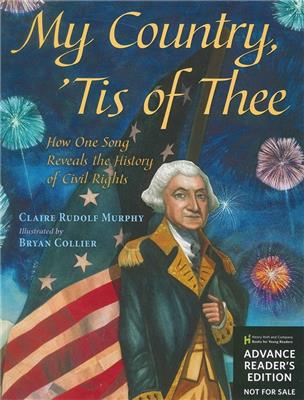Welcome to spring! This month we bring you a new poetry collection from Christina Rossetti. Then discover a fascinating book about the history of “My Country ‘Tis of Thee” for your patriotic and Memorial Day observances at the end of the month. Additionally, we are looking for “guest bloggers” to be featured in our Children’s Book of the Month series next school year. If you have an interest in sharing your expertise, see the end of this blog for details. Happy May!
Early Elementary
Blooming Beneath the Sun
Poems by Christina Rossetti
Art by Ashley Bryan

This new collection of poems by Christina Rossetti is brought to life by beautiful collage-style illustrations by Ashley Bryan. There are 13 poems in all, and each is short, rhythmic, and to-the-point.
Classroom Application
You may ask, “Why are you promoting a book of poems that has nothing to do with music?” Its because poems are a wonderful tool for several creative projects in the music classroom if you have an open mind and some adventurous students! After all, song lyrics ARE poetry when it comes down to it!
Create a melody for the poem
Break your students up into groups and assign them each one of the shorter poems. Ask them to speak the poem and find the “rhythm” of the words. Figure out which stanzas sound the same rhythmically and create a simple melody for those similar lines. Then create a different melody for lines that don’t match the first rhythm, and you’re set! Students can use any sort of pitched percussion or barred instruments to work out their tunes. Finally, have them add some unpitched percussion and they can perform their poem!
Use poems as transitions between concert pieces
Create a themed concert around several poems with the same subject – or around a certain type of poem (haiku, nursery rhymes, etc…). Assign a student or group to read one of the poems in between songs as the rest of the students set up the next piece or get into their next places. This activity keeps the attention of the students moving around, and ties everything together! Another option is to go a step further by selecting a poem to act out! Have students get into groups and decide what the poem would look like using movement and speech. Then, the students can perform for each other with 1 or 2 students reading the poem, while the others act it out silently! There are a number of ways to do this. These “vignettes” could also make nice transitions, rather than simply reading the poems. We have to thank Orff Level I teacher, Meg Tietz, for this idea.
Blooming Beneath the Sun has several creative poems that would work well for either of these ideas. They’re short, rhythmic, and beg to be acted out! The illustrations give some clues, but the students can truly take them to the next level.
Need poetry resources?
The web is a wonderful source for inspiration and traditional lesson plans (but can’t replace a printed collection of poetry, of course!). Here are a few sites we particularly enjoy:
https://www.poets.org/poetsorg/poems-kids
https://www.britannica.com/biography/Christina-Rossetti
Later Elementary
My Country, ‘Tis of Thee: How One Song Reveals the History of Civil Rights
by Claire Rudolf Murphy
Illustrated by Bryan Collier

May brings us Memorial Day, a day when we honor those who have served our country in our armed forces. It’s also a great time to bring out your patriotic music to make sure students keep these classic songs front-and-center in their minds. Each of the iconic songs has a long and rich history that most of us haven’t had a chance to learn. However, Claire Rudolf Murphy and Bryan Collier do us an excellent service by teaching us about “My Country ‘Tis of Thee” and the many forms it took over its long history.
“My Country ‘Tis of Thee” Origins
Did you know that this song was originally a British song (and still is – with different words than we know)? That’s how we came to sing it here – it came over with the first English settlers. The song as we traditionally know it was written in 1831 by Samuel Francis Smith. However, various groups of people throughout history have written alternate verses to this song, tracing the history of the United States as it evolved. British colonists, women protesting for the freedom to vote, slaves, Civil War soldiers, labor activists, school children, American Indians, Martin Luther King, Jr. – there are additional verses included in this book for each group listed, plus more.
It’s a rich collection of verses most people never have the chance to learn, and it helps to understand the meaning of the song by knowing its history. Finally – the actual music for the song is printed in the back of the book in 4-part harmony.
Classroom Applications
There are several things you could do with this book:
Present a concert for the community (or an “informance” for parents, etc…) with as many of the verses as possible, along with students explaining the background of each verse.
Break students into groups and assign a different verse to each group. How does the context of each verse change how the accompaniment might sound? Have students listen to other music of that time and see if they can come up with a different rhythm pattern or melodic variation based on music of the time.
There are several additional resources listed at the end of this book to branch off into the other musical genres mentioned in this book: suffrage songs, Revolutionary War songs, abolitionist songs, labor songs, music of Marian Anderson, music of Aretha Franklin, and more. Explore these other song types with students and present one of each of them, along with the verse from that time, in a concert for others to expand the program and enrich the student understanding of history.
Finally, the author has created a place to submit additional verses, called the “My Country Tis of Thee Music Project.” Have your class write a new verse and submit it – Claire Rudolf Murphy may include it on her website! You can also listen to performances of each of the verses in the book on this web page.
Do You have a Book Lesson to Share?
We get our best ideas from teachers in the field, and we are looking for guest bloggers for our next season of Children’s Books of the Month. If you would like to share a children’s book (and your lesson for it) with us, send an email to Andrea (apelloquin@westmusic.com) with the book and your lesson idea. Thanks in advance for sharing your expertise with our West Music Community!
Andrea Pelloquin is the Education Consultant specializing in print materials, recorders, Nuvo instruments, and puppets at West Music. She is a former public school music teacher and has spent the last 15 years in the world of music publishing and retail. She has also maintained a private flute and piano studio for over 20 years. She welcomes suggestions and recommendations from our community of teachers.




